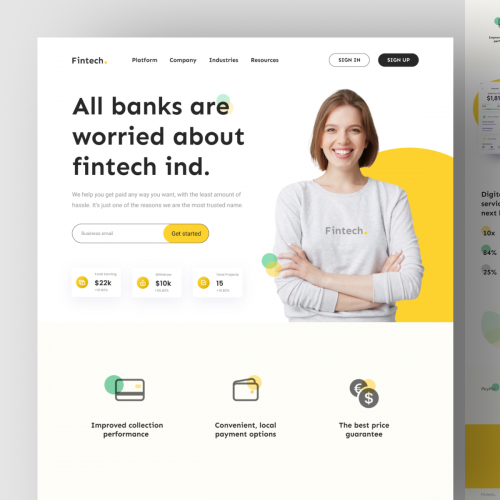Top Tips for Producing an Impactful Website Design That Converts
To accomplish this, one should consider a range of elements, consisting of recognizing the target audience, focusing on customer experience, and maximizing for mobile platforms. The calculated use of compelling call-to-actions and a distinct aesthetic pecking order plays a crucial function in guiding users through their journey.

Understand Your Target Target Market
Recognizing your target market is essential to efficient internet site style, as it lays the foundation for developing an interesting user experience. Recognizing that your individuals are, including their demographics, preferences, and actions, allows designers to tailor the internet site's material, format, and functionality to fulfill details demands.
Conducting comprehensive marketing research is critical in this procedure. Surveys, interviews, and analytics can give valuable insights into user expectations and discomfort points. By compiling this data, developers can produce user characters that stand for different sections of the target market, guaranteeing that layout decisions are notified and relevant.
Additionally, comprehending the target audience aids in selecting suitable design aspects such as color pattern, typography, and images that reverberate with customers. A site that speaks straight to its audience cultivates a feeling of link and trust fund, urging longer gos to and higher conversion rates.
Inevitably, a user-centered strategy to web site design not only boosts customer contentment yet likewise supports company goals by driving interaction and loyalty. By prioritizing the demands and preferences of the target audience, a web site can effectively offer its objective and achieve preferred outcomes.
Prioritize Customer Experience
To boost the overall efficiency of an internet site, prioritizing user experience (UX) is necessary (Website Design). A well-designed UX guarantees that site visitors can browse the site effortlessly, discover info quickly, and engage with content meaningfully. This results in enhanced user fulfillment and higher conversion rates
Begin by executing intuitive navigation. Menus must be realistically structured, enabling customers to find key locations of the website with marginal effort. Uniformity in layout aspects, such as color pattern and typefaces, fosters experience, which is crucial for preserving user engagement.
Furthermore, take into consideration the filling rate of your internet site. A hold-up of simply a few seconds can lead to significant drop-offs, as customers are less likely to wait on a slow-loading page. Enhancing images and enhancing code can improve efficiency and retain site visitors.
By focusing on customer experience, you not only develop a more delightful environment for site visitors yet additionally enhance your brand name's credibility. Ultimately, a focus on UX is an investment in the long-term success of your website.
Optimize for Mobile Gadgets
Enhancing for mobile phones is essential in today's electronic landscape, where an enhancing number of users access websites via smartphones and tablets. A mobile-friendly style not just improves individual experience but also plays a significant role in improving search engine positions. To accomplish this, it is necessary to adopt a responsive layout that automatically readjusts to different screen dimensions and alignments.
Filling speed is another critical variable; mobile individuals are usually less person and expect fast accessibility to information. Maximize photos and take advantage of browser caching to boost performance. Ultimately, test your website on numerous devices and display resolutions to determine and rectify any kind of prospective use problems. By prioritizing mobile optimization, you make sure that your website continues to be competitive and successfully involves a more comprehensive audience.
Use Engaging Call-to-Actions
A site's efficiency usually hinges on its capability to lead site visitors toward desired activities, making engaging call-to-actions (CTAs) essential components of style. CTAs act as the pivotal points that guide individuals to involve with the website, whether that suggests buying, enrolling in an e-newsletter, or downloading and install a source.
To create effective CTAs, clarity is critical. Usage succinct language that plainly connects the activity you want the user to take. Phrases such as "Get Started," "Join Free," or "Store Now" not just communicate necessity yet also eliminate uncertainty. The placement of CTAs is similarly crucial; they need to be purposefully placed throughout the page to guarantee they are quickly noticeable, specifically in high-traffic locations.
Furthermore, think about using directional signs, such as arrows or images, to guide customers toward these switches. By concentrating on these elements, organizations can substantially enhance user engagement, driving conversions and inevitably accomplishing their internet site's goals.
Emphasis on Visual Power Structure
Effective internet site design counts heavily look at this site on a well-structured aesthetic pecking order that guides customers through web content perfectly. By arranging elements in a way that focuses on information, developers can enhance individual experience and facilitate decision-making. This includes making use of size, shade, comparison, and spacing strategically to accentuate the most important parts of a webpage.
Making use of bigger font styles for headings and subheadings develops a clear distinction between various sections, permitting users to check content Visit Website easily. In addition, employing different shades for switches and calls-to-action can capture individual focus and encourage interaction. Whitespace is an additional necessary component; it avoids mess and makes it possible for users to concentrate on crucial messages without distractions.
Pictures and graphics must enhance the text while likewise sticking to the well-known hierarchy, reinforcing the general message (Website Design). Uniformity in style components, such as color schemes and typography, additional reinforces the aesthetic pecking order, making navigation user-friendly

Final Thought
Finally, efficient web site style requires a detailed understanding of the target audience, prioritization of individual experience, and mobile optimization. The tactical use compelling call-to-actions and a well-defined visual hierarchy further boosts customer involvement. By applying these concepts, sites can achieve higher conversion rates, making certain that layout aspects not only attract site visitors however also facilitate smooth navigation and interaction. Eventually, a well-executed internet site design serves as a critical component in driving customer activities and accomplishing business purposes.